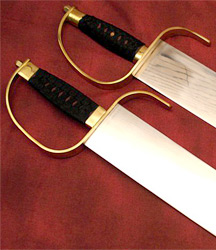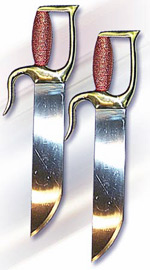|
|
|||||||||
|
The butterfly sword
(Traditional Chinese: húdié shuāng dāo) also known
as dit bang dao (life-taking sword) or
yee
jee dao (character two sword), is originally from the
South of China, though it has seen use in the North. The blade
length is approximately that of the forearm, for easy
concealment within the sleeves or inside boots, and for greater
maneuverability to spin and rotate in close-quarters fighting.
The butterfly sword is usually wielded in pairs. As well, they
are usually held side by side within the same scabbard, so as to
give the appearance of a single weapon. The sword has also a
small crossguard to protect the hands of the wielder, which can
be used to block or hook an opponent's weapon. The guard can
also be used as a knuckle duster when non-lethal application of
the weapon is desired. Traditionally, the blade of a butterfly
sword is only sharpened halfway, from the middle of the blade to
the tip. From the middle down to the handle, the blade is left
blunt. This is done so that the unsharpened portion of the blade
can be used for blocking without damaging a finely honed edge,
and to deliver non-lethal strikes. Butterfly swords are used in
several Chinese martial arts, notably WingTsun( known
as Baat Cham Dao), Lau Gar and Hung Gar.
In WingTsun, one notable aspect of butterfly sword combat is
that its principles are the basis for all other weaponry. In
theory, any object that can be held in the hands of a WingTsun
practitioner will follow basically the same principles of
movement as the butterfly swords. This is because the use of
butterfly swords is simply an extension of empty-handed combat.
Sources: http://en.wikipedia.org/wiki/Butterfly_Sword, www.kultofathena.com
|
|||||||||
|
|
|||||||||
|
|
|||||||||

